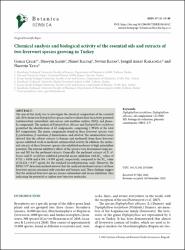Chemical analysis and biological activity of the essential oils and extracts of two liverwort species growing in Turkey

Göster/
Erişim
info:eu-repo/semantics/openAccessTarih
2023Yazar
Çelik, GoncaŞahin, Hüseyin
Baltaş, Nimet
Batan, Nevzat
Karaoğlu, Şengül Alpay
Yaylı, Nurettin
Üst veri
Tüm öğe kaydını gösterKünye
Çelik, G., Şahin, H., Baltaş, N., Batan, N., Karaoğlu, Ş.A. & Yaylı, N. (2023). Chemical analysis and biological activity of the essential oils and extracts of two liverwort species growing in Turkey. Botanica Serbica, 47 (1), 31-40. https://doi.org/10.2298/BOTSERB2301031CÖzet
The aim of this study was to investigate the chemical composition of the essential oils (EOs) from two Diplophyllum species and to evaluate their bioactivity potential [antimicrobial, antioxidant, anti-urease, anti-xanthine oxidase (XO)], and pheno-lic compounds. The analysis of Diplophyllum albicans and Diplophyllum taxifolium permitted the identification of 62 components, comprising >= 99.6% of the total EO composition. The major components found in these liverwort species were (3-patchoulene, (3-santalene, (3-himachalene, and cubebol. The antimicrobial assays showed that the solvent extracts (n-hexane and methanol) from these liverwort species exhibited weak to moderate antimicrobial activity. In addition, the metha-nol extracts of these liverwort species also exhibited moderate to high antioxidant potential. The enzyme inhibitory effects of the species were determined using ure-ase and XO for the methanol extracts. Generally, the methanol extracts of D. al-bicans and D. taxifolium exhibited powerful urease inhibition with IC50 values of 9.711 +/- 0.058 and 6.304 +/- 0.099 mu g/mL, respectively, compared to the IC50 value of 26.124 +/- 0.077 mu g/mL for the standard (acetohydroxamic acid). Moreover, the HPLC-UV detection method showed that the analysed methanol extracts of these liverwort species contained only catechin and benzoic acid. These findings suggest that the analysed liverwort species possess antioxidant and urease inhibition, thus indicating the potential to explore new bioactive molecules.

















